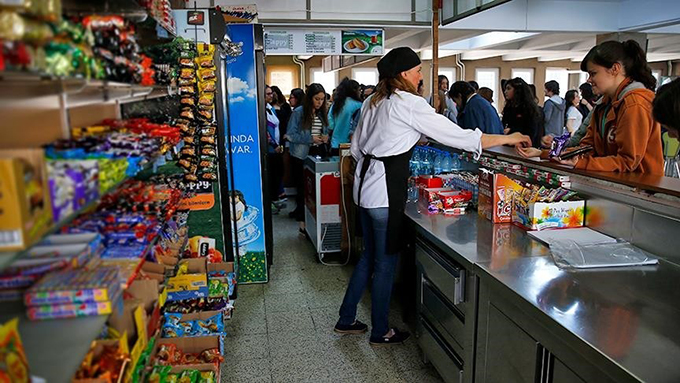
The almost exclusive health concern accorded to the fight against the viral contamination of Covid-19 had initially led the drafters of the draft protocol for the reopening of schools to recommend that school meals be done in each class. Groupings in canteens were indeed considered to be significant risk factors, in line with the opinions of the Scientific Council.
This recommendation was ultimately not retained in the final official version, published on May 3. And we can understand this if we keep in mind that school canteens play a role both health and social which has also been at the very foundation of the national policy for their development.
In this regard we should, in our situation, be particularly sensitive to the context and the nature of the call made in 1917 by Professor Albert Calmette (bacteriologist known for the development of vaccination “BCG” against tuberculosis) faced with the influx into hospitals of under-nourished children and likely to become tuberculous:
“School canteens must be developed, multiplied, made compulsory in all schools because it is absolutely essential to provide the children of the people with healthy and sufficient food for their physical development; it is a national duty. “
Nutritional quality
The call of Professor Calmette was not followed by a concrete start in 1936, at the instigation of one of the first three women to have been part of a government (that of Léon Blum, under the Popular Front), namely Cécile Brunschvicg , Secretary of State for National Education “responsible for school hygiene and the social life of the child” – a title oh so unique and significant …
In 1937, after an investigation, Cécile Brunschvicg published a ministerial report entitled “the question of food at the Ministry of National Education: school canteens” which would be a landmark; and it decrees that from now on there will be an obligation to build a refectory in any new school.
In the aftermath of the Second World War, an instruction of August 30, 1949 from the Minister of National Education Yvon Delbos encouraged the construction of school canteens by allowing the State to subsidize half of the construction costs of the premises allocated to them. The same day, another instruction introduces the first nutritional guidelines by laying down a few principles as to the nature of the food, its diversity, its nutritional quality and its quantity.
Over time, the regulations relating to hygiene and nutritional quality were reinforced, in particular with the circulars of March 6, 1968 and June 9, 1971, and the decree of June 26, 1974.
More recently , the decree of September 30, 2011, accompanied by the decree of the Minister of National Education for school canteens, set out to clarify the principle of the variety of meals by assigning them a new educational mission to taste.
School canteen meals must now be prepared on the basis of around twenty consecutive menus promoting in particular raw vegetables, cooked vegetables, dairy products, meat and fish to the detriment of fried foods, preparations based on minced meat, pastries and ready meals.
Official protocol
Ultimately, in this month of May 2020, what are precisely the recommendations for school meals in the “Health Protocol” which has just been published?
In the file devoted to “Management of half-board in elementary school”, this protocol provides for the case of catering “in the canteen or in the refectory”. “Respect for social distancing measures” must be applied to “all contexts”, from “passage time”, to “circulation”, and “meal distribution”, which implies reviewing the organization of schedules to “limit as much as possible the queues and crossings of students in the corridors”.
If access to the usual premises is not possible, “catering can be done in the classroom under the supervision of an adult and in the form of trays or packed lunches”, in compliance with the rules of hygiene and respect for the cold chain
The protocol goes back to essential barrier gestures: hand washing, wearing of masks by staff, disinfection of furniture or waste management.
Questioned on April 29 on BFMTV and RMC, the Minister of National Education Jean ‑ Michel Blanquer explained that “sometimes, students will be asked to come to school with their meals already prepared”, when the refectory remains inaccessible. This questions other older statements where one of the main reasons for going back to school was that children from socially disadvantaged backgrounds could suffer particularly from confinement in terms of food, or even be in a state of lack of nutrition.
The different actors in the concrete implementation of the protocol should think twice before discarding immediately the way of the school canteen and, consequently, the progress it represents historically, even if that remains to be perfected.
This does not mean that we would then return to the situation which preceded the national policy for the development of school canteens , because history never repeats itself identically.
The pupils of the town hall away from home brought a basket or a haversack each morning where their food was kept, which they placed under the covered courtyard or at the entrance to the class. There was for some bread, a piece of meat, a fruit and a little wine or cider increased by water. Others had neither wine nor cider nor meat; and sometimes not enough bread. Cold or heated meal on the stove when the teacher allowed. And it was usually taken in the courtyard, and often without cutlery.
We will probably not be there. In any case, not quite. But there will be in this case, as in the past situation without school canteens, many disparity problems.
Author Bio: Claude Lelièvre is a Teacher-researcher in educational history, honorary professor at Paris-Descartes at the University of Paris
